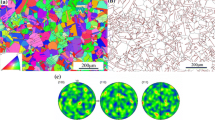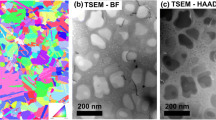Abstract
The change in fatigue failure initiation sites from a surface to subsurface location for two P/M nickel-based superalloys is analyzed. In particular the influences of defect size, shape, and population on the elevated temperature fatigue processes are assessed. The analysis shows that at high strain ranges, crack initiation occurs rapidly, and crack propagation rates determine the fatigue life and failure site. As a result, defect location (related to population) and size are the more important parameters. At lower strain ranges, however, crack initiation is critical in determining the failure origin, and this is primarily controlled by defect shape.
Similar content being viewed by others
References
J. M. Hyzak and I. M. Bernstein:Metall. Trans. A, 1982, vol. 13A, p. 33.
M. Gell and G.R. Leverant:Trans. TMS-A1ME, 1968, vol. 242, p. 1869.
D. Eylon and N. Birla:Metall. Trans. A, 1977, vol. 8A, p. 367.
S. H. Williams and R. Haynes:Powder Met., 1973, vol. 16, p. 387.
G. Bockstiegel and C. A. Blande:Powder Met. International, 1976, vol. 8, p. 155.
F. de Kazinczy:JISI, 1970, vol. 208, p. 851.
F. de Kazinczy:JISI, 1969, vol. 207, p. 40.
J. C. Grosskreutz and G. G. Shaw:Fracture, Second Int’l Conf. Fract., Brighton, P. L. Pratt, ed., Chapman and Hall LTD, London, 1969, p. 620.
Q. L. Moms, O. Buck, and H. L. Marcus:Metall. Trans. A, 1976, vol. 7A, p. 1161.
J. Lankford:Int’l Metals Rev., 1977, vol. 22, p. 221.
M. R. Mitchell:J. Eng. Mat’I and Tech., Trans. ASME, 1977, 99, p. 329.
J. C. Grosskreutz:Metal Fatigue Damage, S. S. Manson, ed., American Society for Testing and Materials, 1971, ASTM STP, vol. 495, p. 3.
J. H. Westbrook, G. Bellows, M. Field, and J. F. Kahles:The Superalloys, C. T. Sims and W. C. Hagel, eds., Wiley and Sons, New York, NY, 1972, p. 557.
F. Rotvel: “Symposium on Random Load Fatigue,” AGARD-CP-118, 1972.
Residual Stress Measurements by X-Ray Diffraction, M. E. Hilley, ed., Soc. of Automotive Engs., 1971, SAE J784a.
G. J. Dnek, Jr., H. H. Smith, and M. R. Achter:Proc. ASTM, 1961, vol. 61, p. 775.
M. R. Achter :Proc. Inst. Environ. Sci., 1963, p. 385.
M. Gell and G. R. Leverant:Fracture, Second Int’l Conf. Fract., Brighton, P. L. Pratt, ed., Chapman and Hall LTD, London, 1969, p. 565.
G.C. Smith:Proc. Royal Society, 1957, vol. A-242, p. 189.
S.S. Manson:Experimental Mechanics, 1965, vol. 5, p. 193.
J. Schijve:Fatigue Crack Propagation, American Society for Testing and Materials, 1967, ASTM STP, vol. 415, p. 415.
P.C. Paris:Flaw Growth and Fracture, American Society for Testing and Materials, 1977, ASTM STP, vol. 631, p. 3.
R. W. Hertzberg:Deformation and Fracture Mechanics of Engineering Materials, John Wiley and Sons, New York, NY, 1976, pp. 273,475.
M. O. Speidel:High Temperature Materials in Gas Turbines, Suhm and Speidel, eds., Elsevier Scientific Publishers, New York, NY, 1974, p. 207.
G. Harkegard:Engr. Fract. Mech., 1974, vol. 6, p. 795.
A. H. Cottrell:Dislocations and Plastic Flow in Crystals, Oxford, Clarendon Press, 1953, p. 86.
J. R. Rice:Fatigue Crack Propagation, American Society for Testing and Materials, ASTM STP, vol. 415, p. 247.
J. R. Rice:J. Appl. Mech., Trans. ASME, 1968, vol. 90, p. 370.
D. F. Mowbray:Cracks and Fracture, American Society for Testing and Materials, 1976, ASTM STP, vol. 601, p. 33.
T. H. Topper and M.H. ElHaddad:Canadian Met. Quart., 1979, vol. 18, p. 207.
N. E. Dowling:Cracks and Fracture, American Society for Testing and Materials, 1976, ASTM STP, vol. 601, p. 19.
G. R. Irwin:J. Appl. Mech., 29, Trans. Amer. Soc. Mech. Eng., Series E, 1962, vol. 84, p. 651.
P. Bentherm and W. T. Koiter:Methods of Analysis of Crack Problems, G.C. Sih, ed., Noordhoff International, 1972, p. 131.
C. F. Tiffany and J. N. Masters:Fracture Toughness Testing and Its Applications, American Society for Testing and Materials, 1964, ASTM STP, vol. 381, p. 249.
R. B. Scarlin:Fracture 77, 4th Int’l Conf. Fract., Waterloo, Pergamon Press, New York, NY, 1977, vol. 2, p. 849.
L. A. James and R. L. Knecht:Met. Trans. A., 1975, vol. 6A, p. 109.
B. A. Cowles, D. L. Sims, and J. R. Warren: “Evaluation of the Cyclic Behavior of Aircraft Turbine Disk Alloys,” NASA Report CR-159409, 1978.
V. Shahani and H. G. Popp: “Evaluation of the Cyclic Behavior of Aircraft Turbine Disk Alloys,” NASA Report CR-159433, 1978.
Author information
Authors and Affiliations
Additional information
Formerly with Metals and Ceramics Division, Air Force Materials Laboratory, Wright-Patterson AFB, OH.
Rights and permissions
About this article
Cite this article
Hyzak, J.M., Bernstein, I.M. The effect of defects on the fatigue crack initiation process in two p/m superalloys: part ii. surface-subsurface transition. Metall Trans A 13, 45–52 (1982). https://doi.org/10.1007/BF02642414
Received:
Issue Date:
DOI: https://doi.org/10.1007/BF02642414




